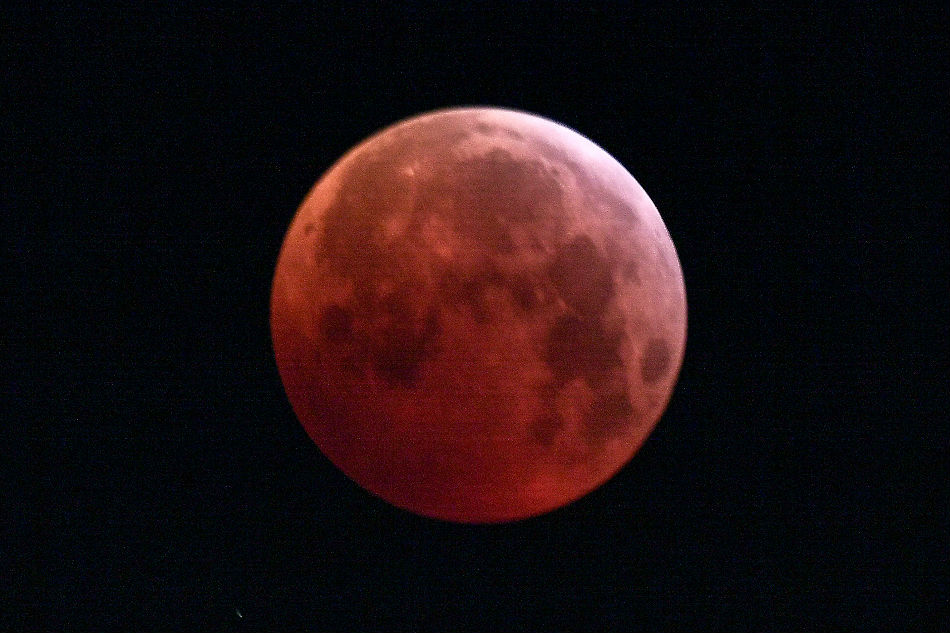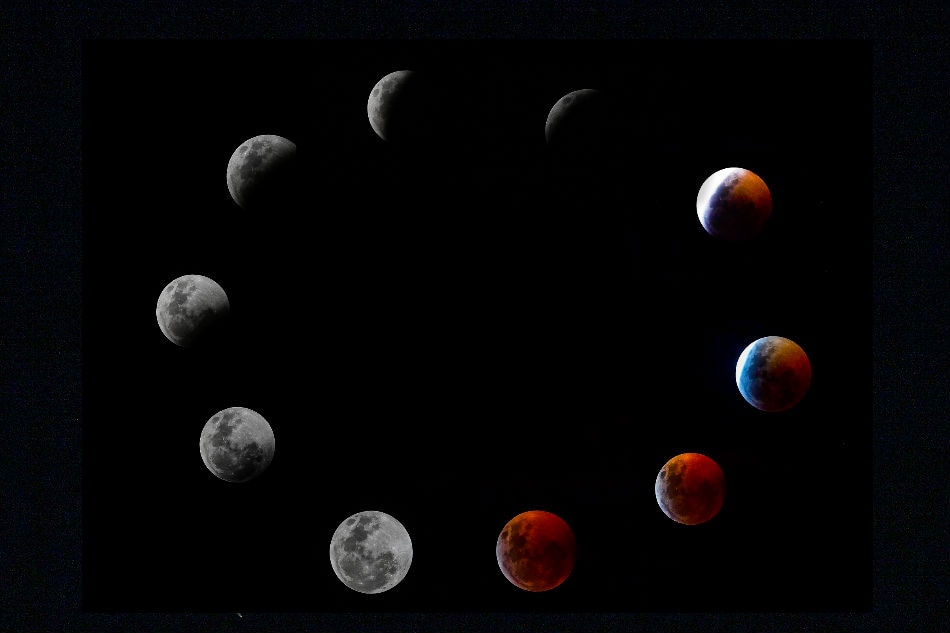Total lunar eclipse woos sky watchers | ABS-CBN
ADVERTISEMENT

Welcome, Kapamilya! We use cookies to improve your browsing experience. Continuing to use this site means you agree to our use of cookies. Tell me more!
Total lunar eclipse woos sky watchers
Total lunar eclipse woos sky watchers
Agence France-Presse
Published Jan 21, 2019 04:10 PM PHT
WASHINGTON - An unusual set of celestial circumstances came together over Sunday night and the wee hours of Monday for sky watchers in Europe, Africa and the Americas, where the moon was fully obscured before lighting up again with a faint red glow.
WASHINGTON - An unusual set of celestial circumstances came together over Sunday night and the wee hours of Monday for sky watchers in Europe, Africa and the Americas, where the moon was fully obscured before lighting up again with a faint red glow.
In the streets of Mexico City, Los Angeles and Paris and in the Moroccan desert, moon gazers turned to the sky to observe the phenomenon, around midnight in the Americas, and shortly before dawn in Europe and Africa.
In the streets of Mexico City, Los Angeles and Paris and in the Moroccan desert, moon gazers turned to the sky to observe the phenomenon, around midnight in the Americas, and shortly before dawn in Europe and Africa.
The eclipse lasted about three hours: during the first hour the full moon was gradually swallowed up by the shadow of the Earth, then an hour of total eclipse where it was not invisible but instead appeared tinted in hues of red, orange and pink, followed finally by its full reemergence, bright and shining.
The eclipse lasted about three hours: during the first hour the full moon was gradually swallowed up by the shadow of the Earth, then an hour of total eclipse where it was not invisible but instead appeared tinted in hues of red, orange and pink, followed finally by its full reemergence, bright and shining.
The full Moon appeared bigger than normal because it was closer to the Earth -- about 222,000 miles (358,000 kilometers) away -- earning it the nickname "super Moon."
The full Moon appeared bigger than normal because it was closer to the Earth -- about 222,000 miles (358,000 kilometers) away -- earning it the nickname "super Moon."
ADVERTISEMENT
Other monikers include a "Wolf Moon," a traditional way of coining an eclipse in the month of January, and a "Blood Moon" because of its rusty, red color. Hence the name for this year's event: a "super blood wolf Moon."
Other monikers include a "Wolf Moon," a traditional way of coining an eclipse in the month of January, and a "Blood Moon" because of its rusty, red color. Hence the name for this year's event: a "super blood wolf Moon."
At its peak, where night skies were clear of clouds, Venus and Jupiter shone brightly in the night sky.
At its peak, where night skies were clear of clouds, Venus and Jupiter shone brightly in the night sky.
Not everyone was fortunate: in London, for example, astronomy enthusiasts hopes were dashed by a cloudy night.
Not everyone was fortunate: in London, for example, astronomy enthusiasts hopes were dashed by a cloudy night.
WHY RED?
WHY RED?
During a lunar eclipse, the Moon appears red because the light of the Sun no longer directly illuminates it, since Earth is passing in between the Moon and Sun.
During a lunar eclipse, the Moon appears red because the light of the Sun no longer directly illuminates it, since Earth is passing in between the Moon and Sun.
ADVERTISEMENT
"The color is due to Rayleigh scattering -- where the Sun's blue light is scattered off molecules in Earth's atmosphere -- which also happens at sunsets," explained the Royal Astronomical Society of Britain.
"The color is due to Rayleigh scattering -- where the Sun's blue light is scattered off molecules in Earth's atmosphere -- which also happens at sunsets," explained the Royal Astronomical Society of Britain.
"The Sun's red light is scattered much less by air, and is bent by Earth's atmosphere in a process called refraction, traveling all the way through it to light up the Moon's surface."
"The Sun's red light is scattered much less by air, and is bent by Earth's atmosphere in a process called refraction, traveling all the way through it to light up the Moon's surface."
LAST ECLIPSE
LAST ECLIPSE
Total or partial lunar eclipses happen at least twice a year on average, Florent Deleflie, an astronomer at the Observatory of Paris-PSL told AFP. It's just that they are not visible everywhere.
Total or partial lunar eclipses happen at least twice a year on average, Florent Deleflie, an astronomer at the Observatory of Paris-PSL told AFP. It's just that they are not visible everywhere.
It's a rare event when a total lunar eclipse is visible on so many parts of the Earth's land mass, as is the case Monday.
It's a rare event when a total lunar eclipse is visible on so many parts of the Earth's land mass, as is the case Monday.
ADVERTISEMENT
Europeans last saw a total lunar eclipse in July 2018. The next chance for a glimpse at a lunar eclipse will be in 2022, but the entire continent won't be able to see the totality of a lunar eclipse again until 2029.
Europeans last saw a total lunar eclipse in July 2018. The next chance for a glimpse at a lunar eclipse will be in 2022, but the entire continent won't be able to see the totality of a lunar eclipse again until 2029.
North Americans may get their next glimpse of a blood moon in 2021 along the West coast and 2022 on the East coast.
North Americans may get their next glimpse of a blood moon in 2021 along the West coast and 2022 on the East coast.
ico-ksh/ia/wdb
ico-ksh/ia/wdb
© Agence France-Presse
© Agence France-Presse
ADVERTISEMENT
ADVERTISEMENT




